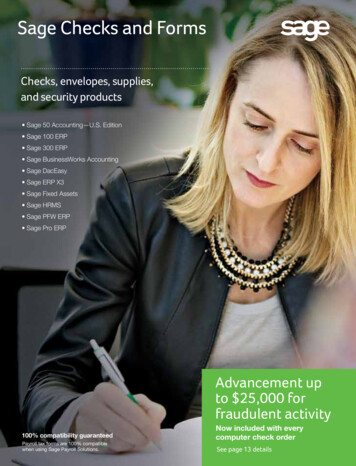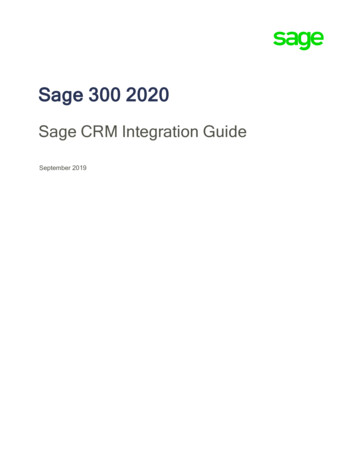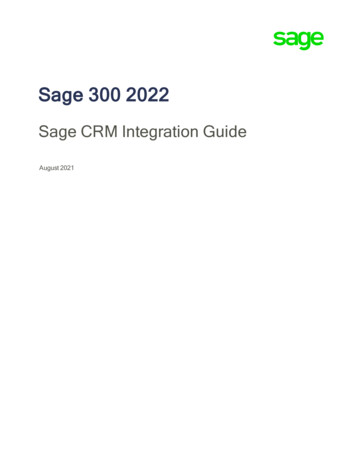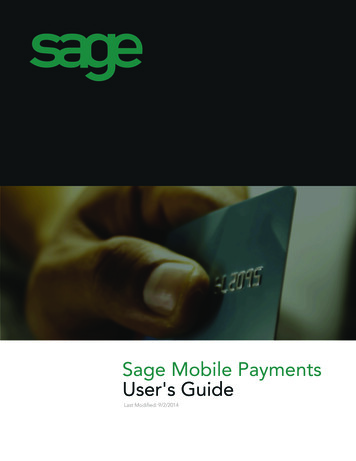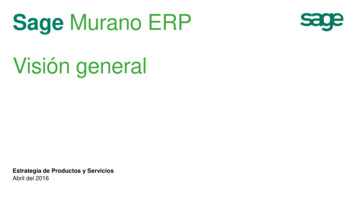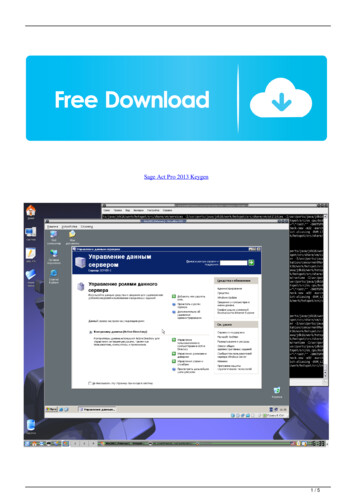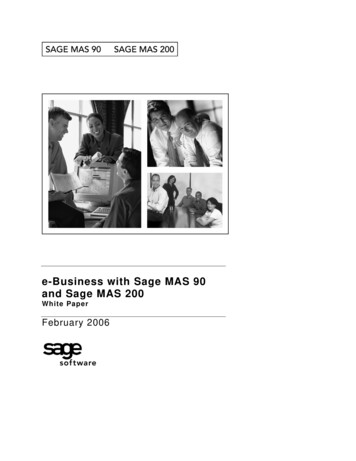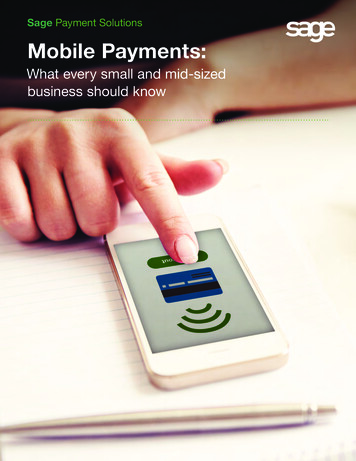
Transcription
Sage Payment SolutionsMobile Payments:What every small and mid-sizedbusiness should know
Sage Payment SolutionsMobile Payments: What every small and mid-sized business should knowOVERVIEWUp until rather recently, for many small and medium-sized businesses withouta traditional brick and mortar facility, the only viable option for a mobilepayment system consisted solely of check and cash transactions, often usinga gray metal cash box holding a tray with compartments for twenty, ten, fiveand one dollar bills and smaller compartments for coins. A single lock wasconsidered security.For other businesses, such as those in construction or offering home orprofessional services and/or non-profits organizations, getting paid usuallymeant leaving an invoice and hoping the customer paid promptly or waitingfor a check to clear the bank.No longer! The new mobile economy is upon us!As a result of astounding advances in mobile technologies, accountingsoftware, mobile applications and the evolution of the cloud for data storage,it is possible for smartphones, tablets, laptops and even virtual credit cardterminals to remotely process credit and debit card and other non-cashpayments. Now, even the smallest business can enjoy all of the benefits ofaccepting payments in any form anywhere, no matter where the customermay be, immediately, and, in many cases, for only pennies per transaction.Commercetransactions in the U.S.completed on mobilephones and tablets overthe next five years areexpected to grow to 142 billion, accordingto the research firmForrester.1 Two-thirds ofthose sales will happenvia tablet computers,while the remainder willoccur on smartphones.In this report, we will examine all facets of mobile payment processing,beginning with a very brief history of mobile payments and forecasts for thefuture. We will then explore the benefits of mobility for small and mid-sizedbusinesses, the ease of processing mobile payments, the equipment requiredand the issues small and mid-sized businesses should take into considerationwhen taking your business mobile.1US Mobile Payments Forecast, 2014 to 2019; https://www.forrester.com/US Mobile Payments Forecast 2014 To 2019/fulltext/-/E-RES1154982
Sage Payment SolutionsMobile Payments: What every small and mid-sized business should knowA (VERY) BRIEF HISTORY AND FORECAST FOR MOBILE PAYMENTSIn 1997 in Finland, Coca-Cola is believed to have been the first business toallow customers to send a text message to purchase its products.In 2011, Girl Scouts of America introduced a mobile payment solution to38 Girl Scout Councils in 26 states that was specifically created by SagePayment Solutions to accept credit cards to support their annual cookie sale.Also in 2011, Google introduced the Google Wallet mobile paymentsystem. It uses a mobile app to store credit, debit and loyalty cards thatallows customers to pay via thousands of PayPass terminals at storesacross the U.S.In 2014, Apple introduced its mobile payment system, Apple Pay, whichallows consumers to use iPhone6 and Apple watch to make purchases atstore checkout.Merchant Content Exchange (MCX) has slowly been unveiling its mobilepayment platform, CurrentC, which is expected to be widely accepted bymajor retailers throughout the US sometime in 2015.The mobile economy is blooming at an even faster rate than expected—by 2017 it will be valued at 3.1 trillion, 200 billion more than the 2.9 trillionYankee Group forecasted in October 2012.2However, while forecasts seem positive for Apple Pay, Android Pay (Google’s relaunch of Google Wallet that will be preinstalled on many Android phones in the near future), and other mobile payment solutions, most consumers still preferto pay with credit cards. In fact, by 2017 just 23% of all point-of-sale purchases are expected to be made with cash,while more than three-quarters of transactions will be conducted with credit and debit cards, according to a study bymarket research firm Javelin Strategy & Research.3As a result of this final point, and even though the methods of mobile payments are evolving, this report will focus onwhy and how small and mid-sized businesses will be best served by moving towards a mobile payment solution thataccepts credit and debit cards in order to compete in today and tomorrow’s marketplace.23“Mobile Metrics That Matter: Growing the New Mobile Economy,” http://www.yankeegroup.com/about us/press releases/2014-02-06.htmlMobile Proximity Payments Forecast 2015; https://www.javelinstrategy.com/brochure/3553
Sage Payment SolutionsMobile Payments: What every small and mid-sized business should knowBENEFITS FOR BUSINESSES GOING MOBILEAbility to accept larger transactionsAccording to Bankrate.com, 78% of Americans now carry less than 50in cash, fifty percent say they carry less than 20, and 9 percent say theydon’t carry cash at all.4 In addition, in a GOBankingRates survey conductedin March, 2014 which asked how often banking customers wrote personalchecks, the most common response was “never” (37.8%), followed by“several times a month” (25.6%), “a few times a year” (20.5%) and“once a month” (16.1%).5How often banking customerswrote personal checksA few years ago, before credit card payment processing went mobile, thissort of news might have been especially troubling for small and mid-sizedretailers that do not accept credit and debit cards. With people having lesscash on hand today, those same businesses face losing sales if their itemcosts 25 and the customer only has 20 on them.Mobile payment processing has changed the game entirely for small andmid-sized businesses that once could only accept cash. Thanks to the abilityto use smartphones to accept credit cards with a card reader, everything abusiness needs can be carried in a pocket and there are no constraints towhere they sell, what they can charge or how much a customer can spend.This is especially great news for those who sell goods at farmer and fleamarkets, trade shows, outdoor events and art fairs, as well as for sidewalkvendors and cab drivers. The possibilities for so many small and mid-sizedbusinesses are limitless thanks to mobile payment processing.45Financial Security Index: Cash’s Cachet; tes Finds 38% of Americans Have Quit Writing Checks; percent-americans-quit-writing-checks/4
Sage Payment SolutionsMobile Payments: What every small and mid-sized business should knowLink transactions directly to accounting systemsIt is possible, and actually preferable, to find a mobile payment processingsolution that allows every transaction to flow automatically into thebusiness accounting system. Seamlessly integrating payments into abusiness management system saves both time and money by eliminatingthe need to manually enter receipts at the end of every business day.Advantages for integrating payments for small and mid-sized businesses: Improved cash flow – Every transaction can be automatically depositedinto a bank account and instantly available to pay suppliers, employeesand other costs, greatly reducing payment cycles. Reduce errors – Manually entering data at both the point of sale andagain later into the accounting system presents more opportunity forhuman error. That is eliminated when data is automatically integratedbetween the two at the moment payment is accepted. Save time – Time once spent on data-entry tasks can now be used toimprove marketing, sales and customer service.Easy to useAny small to mid-sized business can be up and running with the right mobilecredit card payment solution in no time.First of all, most mobile credit card payment applications can be quicklydownloaded from the Apple Store or Google Play.At the front end, where cards are accepted, all that is needed is a card reader,obtained from the mobile payment processor, which plugs directly into asmartphone or tablet. Almost everyone is familiar with the process of swipinga card through a reader at counter terminals and doing the same through amobile card reader is really no different.Once the card is swiped, completing the payment can also be very easy.Many mobile credit card processors provide easy to understand andclear steps on the device’s screen that require minimal effort to collect thecustomer’s signature and either print a receipt on a mobile printer or send itto the customer’s email address. In addition, many solutions will automaticallycalculate taxes or tips for each sale.5
Sage Payment SolutionsMobile Payments: What every small and mid-sized business should knowMOBILE PAYMENT PROCESSINGIS NOT JUST FOR RETAILMany small and medium-sized businesses that are not retail operationscan also get the benefits of processing credit and debit cards using asmartphone. The ability to accept credit card payments away from theoffice or through a mobile device is a valuable opportunity for all typesof businesses to improve cash flow and increase sales and income.Mobility for contractors and construction businessesConstruction companies stand perhaps the greatest risk of failure due tocash flow problems than all other businesses.6 It has traditionally been abusiness sector that relies on initial cash outlays or extension of creditfor labor, goods, tools and equipment in order to perform contractedwork and then waits for invoiced payments or checks from clients toclear the bank in order to pay outstanding debts.For most contractors who work in the field and on job sites, usinga mobile payment process presents tremendous opportunities tominimize cash flow problems and reduce other risks: Accept payments for deposits, installments andfinal balances as work progresses or is completed Allow clients to use their own credit cards topay large sums immediately rather thanstretch payments over time Avoid the possibility of lost checksor checks that bounce Save valuable time by doing away withtrips to the bank to make deposits6Ihab Adel Ismail, Financial Cash Flow Determinants of Company Failure in the Construction Industry (The University of Michigan, 2014)6
Sage Payment SolutionsMobile Payments: What every small and mid-sized business should knowService-based businesses can benefit from mobile payment processingTime is money. That is especially true for small and medium-sized servicebased businesses. Tasks that take away from time spent working directlywith clients, such as billing and bookkeeping, eats into profits. With mobileprocessing a business can collect payment upon completion of the serviceand instantly receive fund approval. Invoicing for service companies, such ascarpet-cleaning or lawn care, is quickly becoming a thing of the past. Mobilepayment processing reduces collection efforts and the need to prepare andsend invoices.There are other advantages to using smartphones and tablets to completebusiness transactions for service-based businesses: Every member of the work staff is able to accept payments and everyemployee becomes a cashier As businesses evolve and grow, the role of integrating paymentswith accounting processes also evolve. Mobile payment processesmake this possible Unlike mobile card readers, on-site card readers can have costlymonthly rental feesNon-profit organizations increase donations with mobile paymentsWhether a non-profit organization accepts simple donations, hosts silentauctions, accepts admission based on donations, or sells postcards, stickersor t-shirts, having the ability to accept credit or debit card transactions hasbecome essential to maximizing revenue.Non-profits can seizeupon other opportunitiesto increase donationsand find new revenuestreams: Sell cause relatedmerchandise at boothsand informationalevents no matter wherethe event is held Encourage largerdonations by offeringadvantages of usingcredit cards ratherthan cash on hand Track donationsmore effectivelyand immediatelyacknowledgedonor’s kindnessA case in point is the Girl Scouts of America. Since 2012, 32 Girl ScoutCouncils in 23 states, representing more than 40,000 troops, have beenusing Sage Mobile Payments to process payments during their annual springcookie sale drive. By accepting mobile payments, Girl Scouts in the NorthCarolina Coastal Pines area reported a 13% increase in overall cookie salesthat first year, while the size of average transactions skyrocketed nearlyfourfold, to 80, for Central California South scouts.77Girl Scout Cookies Go Mobile: A Real Sweet Deal; 0527487041032045783143117042577327
Sage Payment SolutionsMobile Payments: What every small and mid-sized business should knowHOW TO BEGIN ACCEPTINGMOBILE PAYMENTSStep one:Find the mobile payment processor that’s right for your businessSince there are a lot of mobile card processing services available, the realchallenge is finding the right processor that not only meets your currentneeds, but can also grow and meet your needs as your business evolves.For instance, fee structures are an important consideration for small andmid-sized businesses. Some services charge per transaction, some offera monthly service fee and others require both. It’s important to take a longrange look at the way you do business and determine which fee option worksbest for you.Other things to consider are whether the payment processor requires acontract or has a set up fee, handles things like automatically adding salestax or allowing tips to be added to sales totals, and offering the ability toemail receipts to customers. In addition, choosing a payment processor fromthe start that offers the ability to grow with your business and will supportmore complex payment solutions down the road will serve you better in thelong run.For companies that experience high volumes of sales at specific times of year,like during holidays or during the summer tourist season, keep in mind that itis usually possible to order multiple card readers for single accounts. In somerare instances, the ability to step up to virtual terminals that are accessedthrough laptops or wireless credit card terminals during peak times mayneed to be taken into account. It might be prudent to make sure your mobilepayment processor can support this.Finally, it is always a good rule of thumb to trust companies that have beenin the mobile payment game for years. With the growing popularity of mobilecredit card processing, there have been a lot of new companies entering themarket that do not have a proven track record of security compliance. Theyalso lack the experience that comes from working with small and mid-sizedbusinesses and helping them grow and prosper.8
Sage Payment SolutionsMobile Payments: What every small and mid-sized business should knowStep two:The equipmentIn terms of equipment required to begin accepting mobile credit cardpayments, chances are you already have the most important componentfor a mobile payment transaction—a smartphone or tablet.The only other piece in the mobile payment process that you will require is amobile credit card reader, a small device that is inserted into the audio jackor paired via Bluetooth with your smartphone or tablet. Your mobile paymentprovider will provide this to you. They come in all shapes and sizes, but theyall perform the same basic function—you simply swipe the card through thereader’s slot. These credit card readers instantly turn a smartphone or tabletinto a credit card payment terminal.Step three:App downloaded, you’re good to goPractically all mobile payment services are available by downloading mobileapplications—or “apps” as they are more commonly known—from GooglePlay or the Apple App Store, so once you’ve decided on the right mobilepayment processor to use, the rest is a snap. Within minutes you’ll be readyto take credit and debit card payments using your smartphone or tablet.Consumers are already very comfortable with the concept of swiping a cardto complete a transaction. There’s very little training required for you and/oryour staff. If you’ve chosen your provider wisely, payments will automaticallybe deposited directly into your bank account and transactions efficientlyintegrated into your accounting system. You’ll immediately begin enjoying allthe benefits of mobile credit and debit card processing.9
Sage Payment SolutionsMobile Payments: What every small and mid-sized business should knowWE DIDN’T FORGET SECURITY.NEITHER SHOULD YOU!We saved this for last, but obviously the very first thing you need to considerwhen selecting a mobile credit card payment provider is “Do they truly valuecardholder security?”According to a Federal Reserve study, “Consumers and Mobile FinancialServices,” consumer concerns about the security of the technology werethe primary reason given for not using mobile payments (42%).8 Consumersare right to be worried. Although the news in 2014 was filled with cyberattacks on the big players, it’s not just Target, Neiman Marcus, HomeDepotand JPMorgan Chase that are under attack. A 2013 Internet Security ThreatReport issued by Symantec Security Response found that 50–70% of databreaches target small businesses.9A 2013 Internet SecurityThreat Report issuedby Symantec SecurityResponse foundthat 50–70% of databreaches targetsmall businesses.Neglecting credit card security can be a costly, if not fatal mistake for smalland mid-sized businesses. According to the Ponemon Institute’s 2015annual study, even the least expensive data breach in the study still cost thecompany upwards of 750,000. In addition, the average cost for each lost orstolen record has also increased. According to the study, the cost per recordincreased by more than 9%, from 136 per record in 2013 to 145 per recordin 2014. In the U.S., the average cost for each lost or stolen record is 201.10In addition, bad news travels fast. With each new report of a credit cardbreach comes the negative publicity that scares off both long-time andpotential customers. While significantly affected by credit card breaches attheir stores and operations, the larger corporations can spend the resourcesto put tighter security measures in place and hire public relations firms to lettheir customers know that steps have been taken to protect card holder data.It may take time, but they can recover. Small and mid-sized businesses donot have this luxury. If customers do not trust that every purchase is secure,they are less likely to ever return.8 Consumers and Mobile Financial Service, March 2015; s-and-mobile-financial-services-report-201503.pdf9 2013 Internet Security Threat Report; ther resources/b-istr main report v18 2012 21291018.en-us.pdf10 2014 Cost of Data Breach Study, From Ponemon Institute, sponsored by IBM; security-services/cost-of-data-breach/10
Sage Payment SolutionsMobile Payments: What every small and mid-sized business should knowFinally, in October 2015, the liability for fraudulent credit cards transactionswill shift from the credit card company, which has historically assumed therisk, to merchants as a result of EMV becoming the global standard for creditcard payments. EMV is a payment system that uses a microchip that holdsinformation unique to the user embedded in a credit card, a major upgradefrom the magnetic strip that was the industry norm. EMV compliance isa topic all its own and it is strongly suggested that every business, andparticularly small and mid-sized businesses, learn how to prepare for thismajor shift in credit card processing.Still, while much of this news might be alarming, there are steps everybusiness, even small and mid-sized ones, can take to assure their customer’scredit card data is secure and reduce their liability for credit card breaches.The first step to maximize security is to make sure your company meets PCIData Security Standards (PCI DSS) and that the provider you select is aPCI SSC Approved Scanning Vendor. The PCI DSS Data Security Standardis a set of requirements designed to ensure that all companies that process,store or transmit credit card information maintain a secure environment.These are requirements every business that accepts, transmits or stores anycardholder data must meet. They are in place to protect your business.Security should be addressed at two very important stages of any mobilecredit/debit card transaction as well: encryption at point of entry with theswipe device and encryption in the software that processes the payment.An encrypting card reader encrypts the data at the “point of swipe” and iscommunicated to the payment application on the phone already encrypted.No usable data is stored on the phone.Software that encrypts data is an added step that further protects valuabledata so that should there be a breach in the system, the information obtainedwould be worthless to the criminals attacking your data.Therefore, the best solution for small and mid-sized businesses that cannotafford expensive IT departments to develop safeguards is to work with acompany that takes the concern out of security issues and lets you run yourbusiness the way you know how.11
Sage Payment SolutionsMobile Payments: What every small and mid-sized business should knowCONCLUSIONAs you can see, there are quite a number of factors that need serious consideration before deciding on the mobilepayment solution that works best for your company. It is important to find a mobile payment processor that will workwith you as your company grows and can simplify the entire process so that you can concentrate on your business andmaking it a success.Change is inevitable for the future of mobile payment processing. Your customers will demand better service and moreoptions as mobile payments become the accepted norm for the way businesses operate. The company you turn toshould be a leader in payment technology.And of course, security will continue to be a major concern. Criminals will always be trying to find new ways to stealyour credit card data. Therefore it cannot be stressed strongly enough that you must find a company that has a trackrecord of working with the banking and credit card industry to develop security products and safeguards to protectyour business.Do your homework now. Find a trusted and experienced mobile payment processor that has a track record of workingwith businesses just like yours. Find a company that offers all payment types and solutions, from simple to complex,that understands your business and will work with you and provide the right answers to all of your mobile paymentquestions. Most importantly, find a company that is prepared to grow with you and nurture your business no matterwhat your situation requires. Once you have, you’ll be able to embrace the benefits and opportunities that the newmobile economy offers.About SageSage goes beyond credit card processing. We help you run your business smarter through simplified accounting, quickand easy setup and getting paid faster. Accept any type of payment, anywhere your customers are located. Plus, you’llsave time by streamlining all payments automatically into your accounting software and running your entire world ofcommerce from a single screen.About Sage Mobile PaymentsAccept credit, debit, and cash payments wherever, whenever your customers are ready to buy. We help small to midsized businesses increase sales by processing transactions anytime, anywhere with fast settlement to maximize cashflow. In addition, automatic syncing payments to your accounting and ERP software will reduce your back office burden,giving you time back in your day.For more information about Sage Mobile Payments, contact us at 1-800-652-2370 or visit www.sagepayments.com.12
Sage Payment SolutionsMobile Payments: What every small and mid-sized business should knowSage Payment Solutions12120 Sunset Hills RoadSuite 500Reston, VA 20190SagePayments.com 2015 Sage Software, Inc. All rights reserved. Sage, Sage Software, the Sage Software logos and the Sage Software product and service names mentioned herein are registered trademarks or trademarks ofSage Software, Inc., or its affiliated entities. All other trademarks are the property of their respective owners. Sage Payment Solutions is a registered ISO/MSP of BMO Harris Bank N.A. Sage Payment Solutionsis a Registered ISO and MSP of: HSBC Bank USA, National Association, Buffalo NY. 07/1513
Sage Payment Solutions Mobile Payments: hat every small and mid-sized business should know 3 A (VERY) BRIEF HISTORY AND FORECAST FOR MOBILE PAYMENTS . Also in 2011, Google introduced the Google Wallet mobile payment system. It uses a mobile app to store credit, debit and loyalty cards that allows customers to pay via thousands of PayPass .
